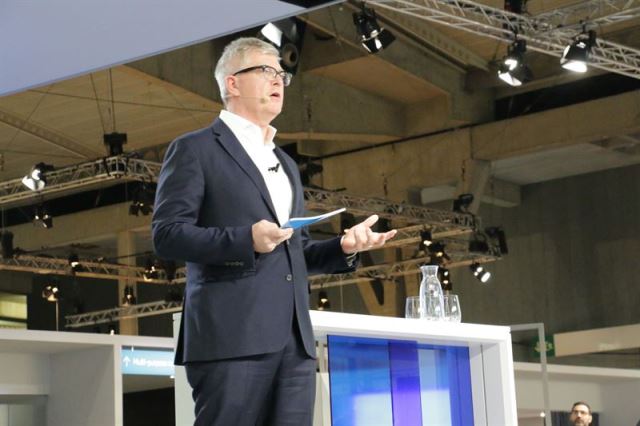 Ericsson CEO Borje Ekholm firmly believes that 5G will bring business to the telecom gear maker.
Ericsson CEO Borje Ekholm firmly believes that 5G will bring business to the telecom gear maker.
In fact, all the major announcements at the Mobile World Congress 2018 are indicting about the future of 5G with Anritsu, Keysight Technologies, Nokia, Ericsson, Huawei, ZTE, Intel, Qualcomm, among others, sharing their deals and innovations.
But the Sweden-based mobile technology company is not confident about a turn-around in its total business in the next few years from a major slump in the 2016-2017. Till recently, Ericsson’s focus under the new CEO was to improve revenue and reduce loss. But Ericsson’s CXO level management failed to prove that it will be making progress going by the Q4 2017 result announced in January 2018.
Ericsson has posted revenue of SEK 57.2 billion (–12 percent) in Q4 and SEK 201.3 billion (–10 percent) in 2017 due to lower sales in all businesses.
Ericsson posted net loss of SEK 18.9 billion in Q4 and net loss of SEK 35.1 billion in 2017. The Sweden-based telecom equipment maker had posted a net loss of SEK 1.6 billion in Q4 2016 and net income of SEK 1.9 billion in 2016.
On the other hand, Nokia networks business posted revenue of EUR 5.827 billion (–4 percent) in Q4 2017 mainly due to variations in foreign exchange rates. Nokia CEO Rajeev Suri is too not confident about a complete revival in its business this year because telecoms are not ready to increase their Capex related investment in the next two years.
Hence, telecom network majors are looking forward for the revival of their business in 2020 or beyond. They do not have any major acquisition strategy as well. Excluding Nokia, none has made a $1 billion plus acquisitions. Since Lenovo and Cisco are going to become more aggressive in telecom market, condition of ZTE, Huawei, Ericsson and Nokia will become more tough in coming quarters.
Huawei has received the 2018 GSMA Award for outstanding contribution to the mobile industry. Ken Hu, acting CEO of Huawei, accepted GSMA Award for Outstanding Contribution to the Mobile Industry from Sunil Bharti Mittal, chairman of GSMA (right) in Barcelona.
Borje Ekholm says the company has a concrete focus on the 5G business cases as well as the key technological enablers – from radio access to network slicing and machine intelligence – that will make 5G and IoT a commercial success.
Ericsson has signed 38 agreements with service providers for 5G trials. Ericsson has signed several commercial contracts with deliveries already by the end of this year. Nokia signed one deal with NTT Docomo.
The industry is expecting that mobile services will make more investment because data traffic is projected to rise at a compound annual growth rate of 40 percent between 2017 and 2023. This means eight times more traffic per site.
Telecom operators are looking for enhanced mobile broadband with more network efficiency. A site fully evolved with 4G and 5G capacity will deliver mobile data at one tenth of the cost compared to a basic 4G site today.
Telstra CEO Andy Penn said the Australia-based company is focusing on the opportunity 5G creates for enterprise segments of Telstra’s business and the company’s desire to always be the leader in customer experience.
“This year, we completed our 5G platform, which comprises the 5G core, radio and transport portfolios, together with OSS, BSS, network services and security. We added 5G commercial software for radio and core networks to enable operators to launch 5G already from Q4 2018,” Borje Ekholm said.
To attract telecom operators to make investment in 5G, Ericsson presented its latest 5G-IoT report at Mobile World Congress today.
The report explains how mobile operators can potentially grow revenues up to 36 percent by addressing 10 key industry sectors.
Operators can add revenue of $204 to $619 billion (12 to 36 percent) to their forecast service revenues of $1.7 trillion in 2026, according to the previous 5G Business Potential report, by targeting digital transformation of other industries, such as automotive and manufacturing, using 5G-IoT technology.
Ericsson said digitalization revenues for ICT players between 2016 and 2026 will grow by 13.6 percent annually, while current operator service revenue growth is forecast at 1.5 percent. Of the total 5G-enabled value in 2026, up to 47 percent is addressable by mobile operators.
CXOs at chipset companies, operators and smartphone makers know the following: lack of promising use cases, lack of availability of 5G devices, lack of investment sources and lack of cost effective spectrum will impact 5G business. They expect that 5G will bring more and will not trouble them again.
Baburajan K





